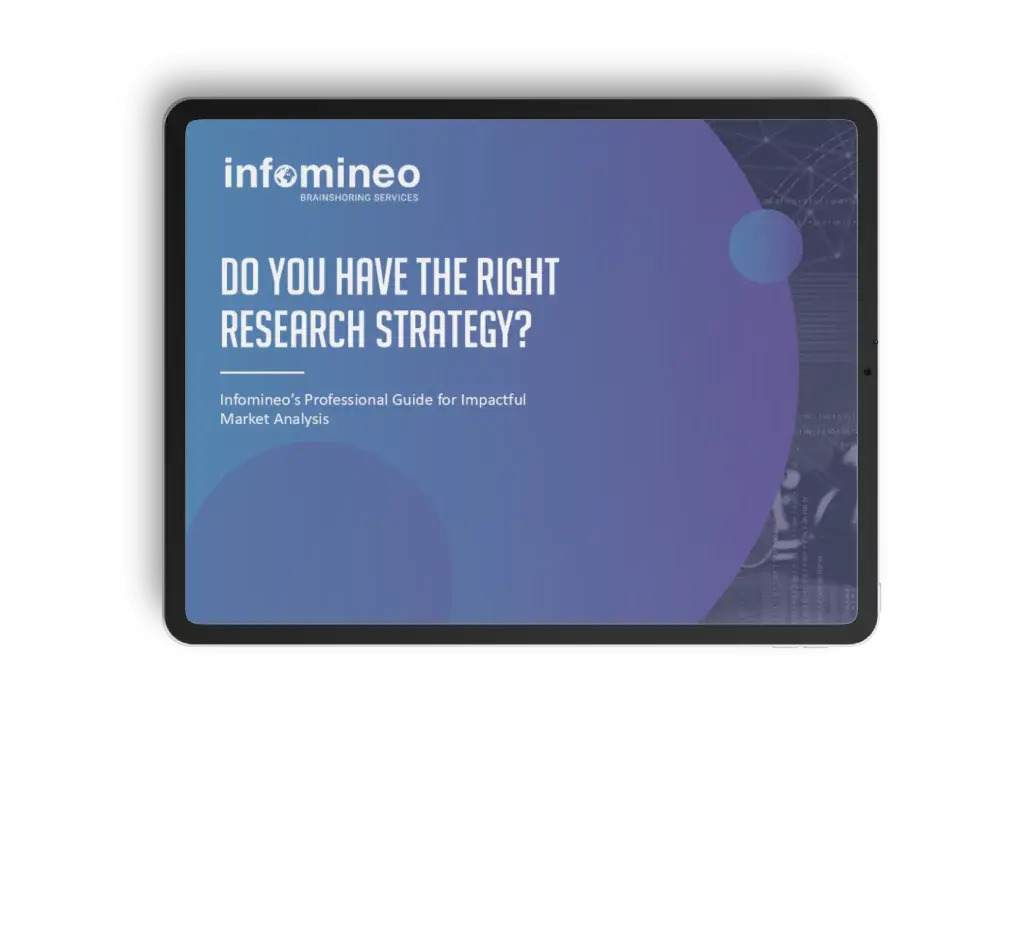Maximizing The Potential of Secondary Research: Balancing Benefits And Challenges

Table of Contents
Secondary research involves identifying and analyzing existing data to generate valuable insights. While it is regarded as a more efficient process than primary research, it is far from straightforward. It entails developing efficient approaches, utilizing multiple sources to enhance the quality and accuracy of the data, and analyzing complex information to fulfill the research objectives. Let’s discuss secondary research and how Infomineo is the bridge between its advantages and complexities.
Understanding Secondary Research
Secondary research, or desk research, examines existing data to gather insights. It involves collecting data from various sources, such as public and premium databases, company websites, industry reports, statistical surveys, news, and official sources such as governments, ministries, statistical offices, and local authorities. Identifying the right sources can often be challenging, especially when handling complex research questions. Proficiency in uncovering relevant and credible sources requires accumulated experience, technical expertise, and critical thinking. This step is crucial, as it impacts not only the accuracy of the data but also all subsequent analyses.
Secondary research comprises two main types: quantitative and qualitative research. Quantitative research draws conclusions through statistical analysis to uncover trends and patterns in datasets. Examples include analyzing the production volume of different companies or determining the market size of a certain industry. Qualitative research, on the other hand, delves into descriptive information such as understanding a company’s product and service offerings or mapping out an entity’s organizational structure.
Use Cases
Secondary research provides a starting point for exploring unfamiliar topics. It includes navigating existing literature, data, and resources to understand key concepts and themes. By providing insights into the current state of knowledge within a particular field or industry, it pinpoints knowledge gaps and areas where information is scarce or outdated. Awareness of the required additional study lays the groundwork for further investigation and analysis.
Secondary research is also useful in building arguments, supporting or challenging existing theories, evaluating the validity of hypotheses, and drawing evidence-based conclusions. With shifting market dynamics, industry reports and competitor profiles provide solid grounds for businesses to gather intelligence on competitors and monitor market trends.
Hence, information provided by secondary research can either validate the findings of primary research or complement them with additional insights, leading to more comprehensive research outcomes.
The Power of Online Data: Advantages of Secondary Research
Secondary research is key to every business and entity, regardless of their focus and mission. Some of its benefits include the ability to navigate a wide pool of information, access premium databases through specialized research providers, and boost time efficiency compared to primary research.
Wide Information Pool
With secondary research, analysts can explore a wide range of information through reputable online sources. This accessibility contrasts with primary research, where data collection often starts from scratch, making secondary research more efficient and versatile for information gathering. While secondary research has opened the doors to vast amounts of information, effectively harnessing and navigating resources requires specialized skills and research expertise to avoid information overload.
Premium Access
While some premium online databases may come with hefty price tags due to their extensive data coverage, clients can sidestep individual subscriptions by outsourcing their research needs to experts. Research providers like Infomineo, for instance, boast subscriptions to these databases, blending their access to comprehensive data with their research expertise, business acumen, and critical thinking. We streamline client costs by charging for comprehensive services that deliver value-added insights.
Time-Efficiency
Unlike the time-consuming nature of primary research, secondary research can yield more results in less time. Even though gathering information from multiple sources or developing proxies can be challenging and time-consuming, the efficiency of the process depends on the complexity of the project and the expertise of the researcher. At Infomineo, we can swiftly develop relevant approaches, identify and leverage credible sources, and analyze and package the extracted data into a digestible format that provides timely and actionable insights to our clients.
Addressing the Challenges of Secondary Research: Key Solutions for Success
Secondary research offers access to relevant databases and information, but it does present certain challenges. To fully benefit from secondary research, it is essential to possess extensive knowledge and technical research expertise.
1. Limited, Outdated, and Unreliable Data.
When researching a particular topic, it is not uncommon to encounter limited, outdated, unreliable, or unavailable data. This especially happens with niche sectors, underdeveloped or emerging markets, and private companies that lack financial disclosure. For example, when analyzing the value chain of a niche market like recycled car parts, you are likely to encounter limited data on the suppliers that collect and distribute these parts. The scarcity and incomprehensive nature of the data can hinder research analysis and outcomes.
Solution
Estimations and proxies are the two main ways of overcoming data limitations and quantifying variables. You can either find estimates in industry reports, financial databases, or other sources, or you can develop your own proxy with the right data and tools. Both need prior alignment with relevant stakeholders on their importance, benefits, and potential limitations. For proxies, the below additional steps should be taken using creative and critical thinking:
- Identifying and defining data gaps.
- Brainstorming on potential indicators that can indirectly reflect the missing data.
- Choosing the indicator that best fits the desired research outcome.
- Testing and running the analysis with the chosen indicator to confirm outcome accuracy and relevancy.
While proxies may seem like a long road, they can sometimes be the only solution for researchers who do not allow data limitations to obstruct their research and project goals.
2. Subscription Requirements
The costs associated with subscription requirements can be inconvenient and act as barriers to effective secondary research. While some data may be accessible through previews and free summaries of paid reports and publications, in-depth information is mostly disclosed in market reports and premium databases that require membership fees.
Solution
This is where service providers like Infomineo come in handy. You can tap into a vast pool of resources, saving you the hassle and cost of individual subscriptions. This allows you to gather comprehensive and up-to-date data across various sectors, regions, and time frames.
3. Data Discrepancies Across Sources
Data discrepancies across sources present a significant challenge in secondary research. These variations can arise between similar sources, like two databases, or across different source types, like a database and a market report. Inconsistencies are mostly due to differences in data collection techniques, reporting standards, and source credibility. Navigating data discrepancies across sources requires scrutiny and thorough validation of information to ensure the reliability and accuracy of results.
Solution:
To assess the reliability of information, it is essential to cross-check various sources to identify the most reliable methodology and the numerical values most frequently repeated across these sources. It is also important to understand the data collection methods of each source. For example, forecast data can differ based on the publisher’s estimation method and the selected base year, while market size data can vary based on the exact components included in its computation.
Through a rigorous validation process, researchers can identify and rectify discrepancies or inconsistencies within datasets, enhancing their trustworthiness and integrity.
4. Information Overload
The challenge of having to navigate numerous data sources and large amounts of data is significant for secondary research. This is particularly true when conducting a deep dive into complex topics. Researchers may encounter difficulties in distinguishing between pertinent data that directly addresses the research questions and supplementary information that may be beneficial but does not directly relate to the research question. Analyzing large amounts of information can be time-consuming and detract from the research objectives, leading to inefficiencies. It is crucial for researchers to keep the end goal in mind at all times to avoid being overwhelmed by the flow of information they encounter throughout their research.
It is also important to keep in mind the time it takes to analyze data and factor it into the research time. This is especially important when faced with time constraints. While exploring certain aspects of the topic or digging deeper might be tempting, it is always important to make sure it doesn’t take away from other tasks. This will help ensure that the research results are comprehensive and delivered on time.
Solution
Proficiency in navigating large amounts of information to address specific research objectives requires specialized experts and professional research providers, such as Infomineo. Through project management, we deliver timely and specific insights that meet and exceed client expectations. Our extensive expertise and collaborative approach allow us to act as thought partners for our clients, providing solutions to any challenges faced during the research process and ensuring efficient business outcomes.
Secondary Research Solutions: Infomineo’s Differentiating Approach to Client Success
Infomineo has extensive experience in secondary research, having served a diverse client base, including consulting firms, Fortune 500 companies, governments, and financial institutions. Efficiency is a core principle of our operations.
Our expertise lies in identifying the most relevant sources for each research question and formulating the most effective methodologies to yield impactful results. Our commitment extends beyond simply providing raw data.
We conduct in-depth analysis to identify discrepancies in data, validate information across multiple sources, and provide concrete answers to your business questions. Our distinctive collaborative and thought-partnership approach enables us to tailor our research solutions to our clients’ specific objectives, needs, and deadlines.
FAQs
What is the difference between primary and secondary research?
The main factor differentiating between the two types of research is the source of the data. Secondary research leverages existing data sets and information from other entities, such as international organizations, governmental bodies, research institutions, and specialized databases. On the other hand, primary research requires the independent collection of raw data from scratch through surveys, in-depth interviews, focus groups, and other data collection techniques.
Are there subscription-free solutions to access high-quality secondary data?
While subscription costs for premium databases can pose a barrier to secondary research, it is important to note that freely available sources can offer good data coverage for a range of themes and industries. These sources include national statistical offices, governmental databases, and international databases provided by organizations such as the UN, OECD, and the European Commission.
How can researchers/businesses maintain a clear research focus?
Analyzing data from several sources can lead to information overload and distract from the research objective. To cut down on excess information, researchers need to structure their data and focus on research objectives. Learning to differentiate between core information directly relevant to your research question and supplementary details that add context can make secondary research more effective and less overwhelming.
How to evaluate the credibility of secondary data sources?
Source credibility is paramount. To assess the credibility of secondary data sources, look for reputable publishers with established research methodologies and transparent data collection practices, as well as cross-check information from diverse sources to understand the rationale behind data discrepancies.
Conclusion and Future Outlook
While secondary research is vital for gaining insights, it presents some challenges, including information limitations such as outdated, unavailable, or unreliable data, subscription requirements for premium sources, and data discrepancies across sources. These challenges can be mitigated through expertise, critical analysis, and appropriate methodologies. Additionally, the emergence of advanced technologies such as Artificial Intelligence can facilitate the navigation of online sources and provide guidance on research questions, increasing the time-efficiency of the research. However, given the obstacles associated with this technology, human expertise remains crucial to fact-check the generated information and draw in-depth analyses.
Take the first step to harness the power of secondary research by exploring how Infomineo can support your research needs.



